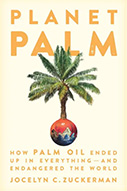Planet Palm: How Palm Oil Ended Up in Everything – And Endangered the World

Author: Jocelyn C. Zuckerman
Publisher: The New Press, 2021. 335 pages
Reviewer: Eusebius Pantja-Pramudya | September 2022
Palm oil emerges under the spotlight of its soaring demand, while also creating complicated consequences for plantations, forests, food or energy, and biodiversity. Jocelyn Zuckerman presents us with a detailed discussion and investigation of the colonial origins and contemporary global picture of palm oil production. Her rich, intimate observation of a controversial issue does not simply blame the commodity or the people involved in its production, but reminds the readers on the utmost need for structural improvement in this sector.
The book starts with a prologue that tells the story of stunning devastation in a landscape of diverse vegetation in West Africa. The devastation stems from the rise of lucrative, large plantation companies that have shifted away from rural subsistence and simple livestock raising. The advent of the palm oil plantation in some ways represents a salvation for poor countries’ thirst for development. Yet the author details how the surge in oil commodity demand has suddenly resulted in a landscape overhaul in West and Central Africa, as well as in Southeast Asia. The author travels to four continents, tracing the flow of commodity, people and capital involved in the palm oil global production network, in three parts of the book.
The Colonial Roots
The first part discusses the historical context and colonial roots of oil palm plantation. The exploration begins in the Niger Delta in 1870s when George Goldie – a British trader known as the “Founder of Nigeria” comparable to Cecil Rhodes – built a business empire from exchanging muskets, alcohol, and trinkets with oil palm from Niger Delta middlemen. Trading activities flourished, but the ensuing violence also cost the local population, who continued to live traditionally, their lives. Ending with the Niger Convention in 1898, the British colonial armed forces claimed control of the Delta’s northwest and northeast areas for the British Government. Goldie, himself, set the model for chartered companies, securing Britain’s access to natural resource, which in this case was palm oil.
The local tribes that were captured were transported as slaves across the Atlantic Ocean to work in the plantation business in Bahia (Brazil), and they brought palm oil as a part of their culture. The slaves grew oil palm as traditional food crop, while their colonial masters were more occupied with other cash crops, like tobacco and sugar. Oil palm fruits then became the local delicacy for the African communities in Bahia, especially after the commercial relationships with West Africa dried in the late 1800s.
The growing import of oil-palm kernels and barrels motivated a businessman named William Lever in Liverpool to identify ingredients for producing soap containing palm oil. The soap brand, Sunlight, took only three years for Lever’s factory to operate in full capacity. The soap business boomed, going public in 1894, and producing 2,400 tons of soap each week in 1897 together with new brands like Lifebuoy, Lux Flakes and Vim. Lever’s business expanded both by going overseas and by having new product lines, such as making margarine as a cheap substitution of butter for the working class. The ever-increasing oil demand pushed Lever to develop exclusive supply contracts. In 1911, a concession contract was signed with the Belgian Kingdom as an effort to redeem its reputation after murdering some 10 million locals in Congo. The World War I outbreak in 1914 collapsed Lever’s market in Germany, but it created another business opportunity to produce glycerin from the soap by-products for the production of gunpowder substitute. Rather than being affected negatively, the value of oil palm and kernels trading skyrocketed. In 1929, Unilever was established as the biggest industrial conglomerate in Europe, which merged Lever Brothers and Margarine Union with United African Company in West Africa. While Lever enjoyed a very good life in England, the Congolese experienced miserable living condition under slavery, with many of them being women and children.
The success of colonial ventures in Africa inspired Henri Fauconnier to team up with Adrien Hallet to establish the La Société Financiére des Caoutchoucs (Socfin), which opened an oil-palm plantation in Bangun Bandar in Deli, Sumatra. This plantation set the example for some of Southeast Asia’s planters who were experiencing an ongoing rubber slump in 1920s, which resulted in the development of oil palm plantations in Sumatra (77,000 acres), Malaysia (growing from 8,400 acres to 50,000 acres within a decade), and in Siam. The Southeast Asian palm oil that went to the United States helped to make high-end soap and margarine brands. Netherland Indies had surpassed Nigeria to become the biggest palm oil producers in the world. It was also Hallet that made tenera popular, with high productivity resulting from the crossbreeding of the widely used dura with pisifera varieties. The palm oil boom in Southeast Asia, which at that time covered an area of 235,000 acres in Sumatra and 57,000 acres in Malaya, ceased with the outbreak of World War II. The post-colonial period of Southeast Asian countries marked the development of the palm oil industry, with Malaysia experiencing twenty-five-fold growth from 1964 to 1984.
Defending the Environment
The second part of the book, consisting of four chapters, covers the business’ environmental dark side. The author discusses the loss of biodiversity, bringing one million species of plants and animals to extinction. Environmental defenders that stood to fight against this natural destruction emerged, including Rudi Putra, an Acehnese environmental activist who was later awarded the Goldman Environmental Prize, and Ian Singleton, a German anthropologist who led the Sumatran Orangutan Conservation Program.
Poaching and conversion to palm oil plantations have played a big role in driving this destruction. The fate of plantation workers, who often lack sufficient knowledge and proper health safety equipment, is discussed in one chapter. Plantation workers, many of which are women, are exposed to hazardous materials in fertilizers and herbicides. One herbicide called paraquat, which has been linked to kidney, lung and liver damage and has been banned in at least forty-six countries, is continuously used on palm oil plantations around the world. There are also cases of violence against women and child labor on these plantations. However, these workers often do not have better alternatives as they strive for a better life.
The controversy of palm oil consumption is also captured in this book. Palm oil can give a powerful answer to food security. However, some studies warn that increasing palm oil consumption could lead to obesity, diabetes, and higher heart-disease risk, as it contains minimal amount of omega-3 and omega-6 fatty acids. People with better income often have options to buy food with less palm oil content. They also may be more likely to be eaten by indigenous communities who have found their jungle-based foods diminished by deforestation and pollution.
Palm oil also rocks political pillars. It can put the lives of journalists and environmental defenders at risk. It also emerges from rampant corruption, linked with decentralized Indonesian politics. Haze can result from land clearing by burning peat forest and land areas, and finding those responsible for the fires are not easy tasks. Land transactions are made through shell companies and backroom deals. Despite threats of violence for those who may want to investigate the land owners, environmental groups, like Eye on the Forest, have persistently conducted undercover investigations of forest conversion and land grab in Sumatra.
Running into a Brick Wall
In the current world in which bad news returns with high clickbait, dreadful stories on palm oil production are still uncommon. Efforts to voice concerns about the impacts of deforestation and consumption of saturated fats through commercial advertisements for products with high content of palm oil ingredients have been difficult. Although past censorship came under the influence of Northern Hemisphere countries, palm oil producing economies have been actively lobbying the media to moderate the negative coverage. Journalists trying to investigate the impacts also face difficult situations, with limited access to information amidst threats and deportation.
In the last part of the book, the author covers the environmental defenders’ campaign to fight against this powerful palm oil industry. The two most notable actions discussed are ship interceptions by Greenpeace that identify tankers that transport oil linked to deforestation and campaign by the Rainforest Action Network (RAN) that target snack producers using “conflict palm oil” linked to land grabbing and forced labor. On the other side, the book also explores the initiatives of environmental NGOs and palm oil buyers to develop a set of environmental and social criteria for recognizing if and how palm oil can be produced in a sustainable way – called the Roundtable on Sustainable Palm Oil (RSPO). Environmental defenders have actively influenced the industry, both directly or through RSPO, to have more progressive measures to improve palm oil sustainability. This happens alongside the unending victimizing that often take the lives of journalists and environmental activists.
The book closes with an epilogue written at the onset of the pandemic. The pandemic shows us the vivid linkage of our health to the health of the planet. We need to overhaul our food system for our survival, which the author frames to argue for major changes to industrial palm oil development. Changes are needed to preserve the remaining peatlands, to protect land of high carbon and conservation value, and to tap into the expertise and holistic sensibilities of indigenous people. Such a progressive agenda should consider that producing countries have had to sacrifice their economy with the sudden divorce of palm oil global consumption. This can be done through a collaborative effort, in which financiers and investors emphasize environmental risks in their portfolio, consumer goods companies adopt no-deforestation policies that cover both direct and indirect suppliers, and consumers raise their voices to demand higher transparency of the industry. All of these changes require us to rethink the capitalist system, what people produce and consume, and how we treat our nature.
Final Notes on the Book
The author’s marvelous investigation into the portrait of the palm oil industry brings readers to various sides of palm oil. However, here I provide four notes of where discussion could be expanded. First, the lens for observing justice in the palm oil industry can be enriched, to some extent, and widened to explore struggles of those who have tried to use palm oil to pave their way for a better life, as well as paint their attempts to seize the opportunity to become entrepreneurs even with their limited knowledge and capital access. Second, discussing palm oil is undeniably important to discussing other energy crises. The enthusiasm for developing palm oil plantations, beyond the plantation development program set up by governments until the middle of 1990s, came at the onset of global disruption to oil prices. As the global oil prices soared, there were some efforts to diversify fuel, in which industrial palm oil became one of the readiest alternatives by offering cheap, highly productive, and chemically-stable fuel. At that time, the world also began to consider vegetable oil. As the global production of palm oil biofuel increased to tackle the rising demand, the pressure to limit and move away from palm oil also has increased as well. Though, up to now, palm oil still provides a strong alternative of energy diversification, with the risk of even worse social and environmental impacts by abandoning people involved in the palm oil production. Third, an alternative path of development needs consideration. The call to overhaul the palm oil industry needs to consider the promotion of different commodities that can be produced from the lands that are currently being used for palm oil production. Particularly, agroforestry products need to be considered. The economic viability of agroforestry, with increasing consumption, commodification and modern style influence, will give many people better opportunities outside palm oil. Fourth, discussion on the transition to a more diversified economy, requiring effective participation of both government and business in the producing countries, will also be important to discuss moving forward.
Eusebius Pantja Pramudya, Institute of Social and Economic Research


